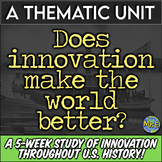Industrial Revolution Inventions: Spinning Jenny, Steam Engine, Telegraph!
- Zip
- Google Apps™

What educators are saying
Also included in
- This thematic unit for United States or American History is designed around the overarching essential question, "Does Innovation Make the World Better?" This guided unit seeks to focus students on one theme over the five-week unit to better understand how innovation has shaped US history throughoutPrice $24.99Original Price $28.97Save $3.98
Description
In this stations-based resource on different inventions during the early Industrial Revolution, students learn about the telegraph, the Spinning Jenny, the steamboat, the mechanical reaper, the steel plow, the process of pasteurization, and the steamboat. Students rotate to different stations in the room where they read about one of the major inventions/achievements of the Industrial Revolution and take relevant notes on a bubble map organizer. Once complete, students answer the overarching prompt, "How did technology revolutionize life in the 19th century?" Students learn about John Deere's Steel Plow, Cyrus McCormick's Mechanical Reaper, Samuel Morse's Telegraph, Robert Fulton's Clermont steamboat, James Hargreave's Spinning Jenny, and Louis Pasteur's process of pasteurization. Included in other exhibits also include details on Cyrus Field's trans-Atlantic cable and Samuel Crompton's Spinning Mule. A final short response essay prompt is included as well!
This resource is included in my United States Industry and Slavery Unit located here!
This resource includes a paper in-class version and a 1:1 Google compatible version to be used in conjunction with Google Classroom. Just follow the included instructions for how to access the Google version, then share the resource through Google or assign via Google Classroom. This will allow students to type directly into the document!
----
Be sure to follow the History with Mr E Facebook page, and don't forget to signup for the Social Studies Newsletter to receive information on flash sales, product releases, and classroom tips!
----






